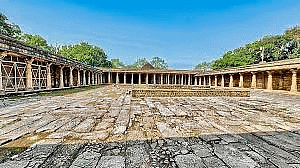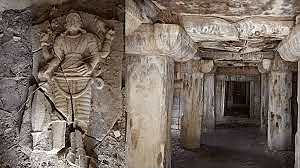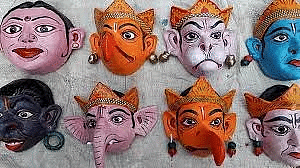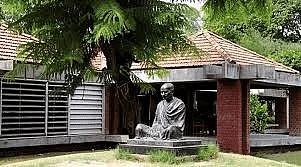CUET Commerce Exam > CUET Commerce Notes > General Test Preparation for CUET UG > History, Art & Culture: March 2024 Current Affairs
History, Art & Culture: March 2024 Current Affairs | General Test Preparation for CUET UG - CUET Commerce PDF Download
Pandavula Gutta and Ramgarh Crater Geo Heritage Sites

Why in News?
Pandavula Gutta, an ancient geological wonder predating the Himalayan range, is officially acknowledged as the exclusive Geo-heritage site in Telangana.
- Additionally, the Rajasthan government designates Ramgarh Crater in Baran district as a geo-heritage site.
- This recognition represents a significant step in safeguarding the geological heritage of the respective regions.
Key Facts About Pandavula Gutta
- Situated in the Jayashankar Bhupalpally district of Telangana, Pandavula Konda (Pandavula Gutta) is a remarkable geological formation.
- It exhibits rock shelters and evidence of human habitation dating from the Mesolithic period (approximately 10,000 B.C. to 8,000 B.C.) to medieval times.
- The site features Palaeolithic cave paintings, dating back to 500,000 BCE–10,000 BCE, portraying various wildlife species and geometric shapes.
- These paintings are adorned with vibrant colors such as green, red, yellow, and white, showcasing a glimpse of prehistoric life.
- Pandavula Gutta's terrain attracts enthusiasts of rock climbing due to its distinctive topography.
Key Facts About Ramgarh Crater
- Formed approximately 165 million years ago due to a meteor impact, Ramgarh Crater in Rajasthan spans 3 kilometers in diameter and plays a crucial role in maintaining the region's ecological balance and biodiversity.
- Recognized as the Ramgarh Conservation Reserve under the Wildlife (Protection) Act, 1972, the crater is safeguarded to preserve its unique ecological and cultural significance.
- Furthermore, it is declared as the Ramgarh Conservation Reserve under the Wildlife (Protection) Act, 1972, and the presence of the Pushkar Talab complex within the crater adds to its significance, recognized as wetlands under Wetland (Conservation & Management) Rules, 2017.
ASI Survey of Bhojshala Complex

The Madhya Pradesh High Court has issued directives to the Archaeological Survey of India (ASI) for conducting a scientific survey of the Bhojshala Temple-Kamal Maula Mosque complex in the Dhar district.
Key Points
- The complex, dating back to the 11th Century CE, is under ASI protection. Hindus perform puja on Tuesdays, while Muslims offer Namaz on Fridays, as per an agreement with the ASI.
- The court has mandated the clarification of the true essence and identity of the entire monument, which falls under the Central government's maintenance.
- Under Section 16 of the Monument Act, 1958, the court has stressed the ASI's constitutional and statutory obligation to conduct a scientific survey promptly.
- The ASI is instructed to document the survey through photography and videography, and to unlock and open sealed rooms and halls within the complex. A comprehensive inventory of all artifacts, idols, deities, and structures found in these sealed areas must be prepared and submitted, along with respective photographs.
- The archaeological site at Dhar is notable for its ancient inscriptions, attracting the attention of colonial Indologists, historians, and administrators since the early years.
- Dhar was mentioned by John Malcolm in 1822, highlighting King Bhoja's building projects such as dams in the region.
- In September 2023, guards reportedly discovered an idol of Goddess Vagdevi, although the administration refuted claims of the idols 'appearing' and removed it.
Temple Discoveries Highlight Chalukya Expansion

Why in News?
Archaeologists from the Public Research Institute of History, Archaeology, and Heritage (PRIHAH) have discovered two ancient temples from the Badami Chalukyan era, as well as a rare inscription, in Mudimanikyam village of Nalgonda district, Telangana.
What are the Major Highlights of the Recent Excavation?
- The temples, situated at the village's outskirts, date from 543 to 750 AD, aligning with the Badami Chalukya reign.
- They feature a distinct architectural fusion of Badami Chalukyan and Kadamba Nagara styles in the Rekha nagara design.
- One temple houses a panavattam, while the other contains a Vishnu idol.
- An inscription dubbed 'Gandaloranru,' from the 8th or 9th century AD, was also found.
- This discovery expands the known extent of the Badami Chalukya influence, previously believed to be limited to Jogulamba temples at Alampur and submerged sites like Yeleswaram.
What are the Key Features Related to the Chalukya Dynasty?
- The Chalukya dynasty, spanning the 6th to 12th centuries, governed substantial territories in southern and central India.
- Comprising three branches — the Chalukyas of Badami, Eastern Chalukyas, and Western Chalukyas — each dynasty held distinct regions and periods of dominance.
- Originating in Vatapi (modern Badami, Karnataka), the Chalukyas of Badami flourished under Pulakeshin II until the mid-8th century.
- The Eastern Chalukyas established an independent kingdom in the eastern Deccan, centered around Vengi (now Andhra Pradesh), until the 11th century.
- The rise of the Rashtrakutas overshadowed the Chalukyas of Badami in the western Deccan, but their legacy continued with the Western Chalukyas, ruling from Kalyani (modern Basavakalyan, Karnataka) until the late 12th century.
- Pulikesin I fortified a hill near Badami, laying the foundation for the Chalukya dynasty.
- Badami was formally established by Kirtivarman, becoming the hub of Chalukya power and culture.
- The Chalukyas organized their realm into Vishayam, Rastram, Nadu, and Grama for efficient governance.
- They were prominent supporters of Saivism, Vaishnavism, Jainism, and Buddhism, reflecting their religious tolerance.
- Chalukyan architecture introduced the use of soft sandstones in temple construction, seen in both excavated cave temples and structural temples.
- Sanskrit was the primary language for official inscriptions, though regional languages like Kannada were also acknowledged.
- Adopting the Vakataka style, Chalukyas contributed to painting, notably seen in cave temples dedicated to Vishnu in Badami.
GI Tag to Majuli masks, Manuscript and Narasapur Crochet Lace Craft

Narasapur Crochet Lace Craft GI Tag
- Region: Limited to 19 mandals in West Godavari, Andhra Pradesh.
- Origins: Emerged around 150 years ago among women in the farming community.
- Initiative: India's first lace park was established in 2004, providing a platform for crochet lace makers.
- Craftsmanship: Thin threads intricately woven with various-sized crochet needles produce vibrant lace in colors like orange, green, blue, white, and beige.
- Global Reach: Products are exported to countries such as the UK, USA, and France.
Majuli Masks GI Tag
- Region: Originating from the river island district of Majuli, Assam.
- Traditional Use: Handmade masks used in bhaonas (devotional theatrical performances) to represent gods, goddesses, demons, animals, and birds.
- Materials: Bamboo, clay, dung, fabric, cotton, and wood.
- Historical Context: Introduced by 15th-16th century reformer saint Srimanta Sankardeva.
- Monastic Tradition: Concentrated in four out of Majuli's 22 sattras, which are monastic institutions established by Srimanta Sankardev and his disciples.
Majuli Manuscript Painting GI Tag
- Origin: Sixteenth-century paintings on sanchi pat manuscripts made from the bark of the sanchi or agar tree, using homemade ink.
- Unique Features: Manuscripts written in Gargayan script, Kaithall, and Bamunia.
- Subject Matter: Depictions of Hindu epic stories, particularly Lord Krishna’s Bhagavata Purana narratives.
- Historical Significance: Patronized by Ahom kings and continues to be practiced in each sattra in Majuli.
What is a GI Tag?
- Definition: A sign indicating a product's specific geographical origin and associated characteristics or reputation.
- Legislation: Governed by the Geographical Indications of Goods (Registration and Protection) Act of 1999 in India.
- Scope: Applies to agricultural products, foodstuffs, wine and spirit drinks, handicrafts, and industrial products.
- Duration: Registration is valid for 10 years, renewable for successive periods of 10 years each.
Benefits of GI Tag
- Legal Protection: Ensures legal protection in India, enhancing exports.
- Prevention: Prevents unauthorized use of a Registered Geographical Indication.
- Economic Prosperity: Boosts the economic prosperity of goods producers in a specific geographical area.
Sabarmati Ashram Redevelopment Project

Context
The redeveloped ‘Kochrab Ashram’ inaugurated by Prime Minister Narendra Modi in Ahmedabad.
Exploring Gandhi's Ashrams
- Sabarmati Ashram Foundation: Prime Minister Narendra Modi commemorated the 94th anniversary of the Dandi March by performing the symbolic 'Ashram Bhoomi Vandana' and revealing the masterplan for the Rs 1,200 crore Gandhi Ashram Memorial and Precinct Development Project on March 12.
- Various Settlements: Gandhi established five settlements during his lifetime, including two in South Africa and three in India.
- South Africa: Phoenix Settlement in Natal and Tolstoy Farm outside Johannesburg.
- India: The first ashram in Ahmedabad's Kocharab in 1915, later moved to Sabarmati in 1917.
- Kocharab: The initial ashram was set up in Kocharab in 1915, initially called the Satyagraha Ashram.
- Sabarmati: Established in 1917 on the western bank of the Sabarmati River, this ashram served as the center for Gandhi's major movements for Indian independence.
- Sewagram: Gandhi's residence and ashram from 1936 until his death in 1948, located in Maharashtra, India.
- History of Sabarmati: Gandhi initiated significant movements like the Dandi March from the Sabarmati Ashram, emphasizing self-sufficiency through manual labor, agriculture, and education. The ashram became a pivotal site for India's struggle for independence, marked by Gandhi's vow not to return until India achieved freedom, a promise unfulfilled due to his assassination in 1948.
The document History, Art & Culture: March 2024 Current Affairs | General Test Preparation for CUET UG - CUET Commerce is a part of the CUET Commerce Course General Test Preparation for CUET UG.
All you need of CUET Commerce at this link: CUET Commerce
|
164 videos|800 docs|1156 tests
|
Related Searches















